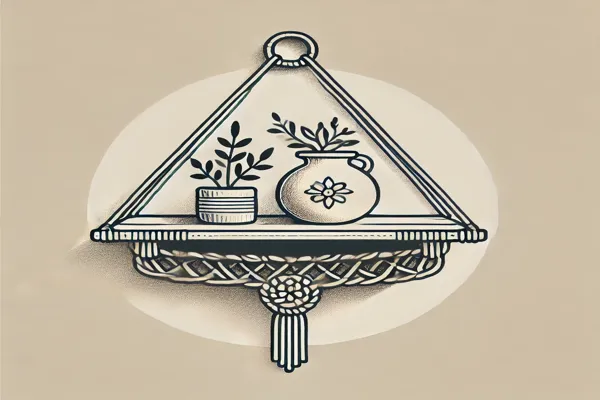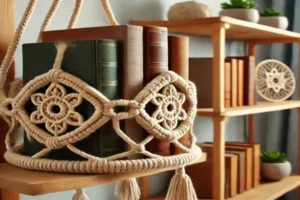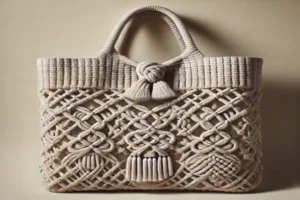Introduction
In today’s world of interior design, functional décor has become a significant trend. Homeowners and decorators alike are increasingly interested in pieces that serve both aesthetic and practical purposes. This trend emphasizes the importance of maximizing space and utility while ensuring that every item contributes to the overall beauty of a room. One of the most popular elements within this trend is macramé, a craft that allows you to create beautiful, handmade items that also serve a functional purpose in your home.
Macramé hanging shelves are an excellent example of functional décor. These shelves not only provide storage space but also add a touch of artistic elegance to any room. The versatility of macramé allows you to customize the design to match your personal style and the existing décor in your home. Whether you need extra storage in a small space or want to create a focal point in a larger room, macramé hanging shelves offer a creative and visually appealing solution.
In this article, we will guide you through the process of making your own macramé hanging shelves. We’ll start by exploring the basic knots and materials you’ll need, followed by a detailed step-by-step guide to creating your shelves. We’ll also provide tips on styling and placing your shelves, ensuring that they enhance your home’s décor while serving a practical purpose. By the end of this article, you’ll have all the knowledge and inspiration you need to create stunning macramé hanging shelves that perfectly blend form and function.
Understanding the Basics of Macramé
Macramé is an ancient craft that involves knotting cords or ropes to create intricate patterns and designs. Originating from Arabic weavers in the 13th century, the word “macramé” comes from the Arabic word “migramah,” meaning “fringe.” Historically, macramé was used to decorate garments and household items, such as towels and curtains, with elaborate fringes. Over time, this craft has evolved and regained popularity, especially during the bohemian movement of the 1970s. Today, macramé is celebrated for its versatility and the ability to create both decorative and functional pieces, such as wall hangings, plant hangers, and, of course, hanging shelves.
To create macramé hanging shelves, you need to master a few essential knots. These knots form the foundation of your design and ensure that your shelves are both sturdy and visually appealing. Here are the basic knots you’ll use in this project:
- Square Knot: One of the most common macramé knots, the square knot is created by crossing two outer cords over two inner cords, forming a secure and symmetrical pattern.
- Lark’s Head Knot: This simple knot is used to attach your cords to a dowel or ring. It’s created by folding a cord in half, placing the loop over the dowel, and pulling the ends through the loop.
- Half Hitch Knot: The half hitch is a versatile knot used to create diagonal or horizontal lines in your design. It’s made by wrapping one cord around another and pulling it through the loop created.
By learning these knots, you’ll have the skills needed to create a strong and beautiful structure for your hanging shelves.
Before you begin your macramé project, it’s important to gather all the necessary materials. Having the right tools and supplies will make the process smoother and ensure a successful outcome. Here’s what you’ll need:
- Rope: Choose a strong, durable rope for your project. Cotton rope is a popular choice for macramé because it’s easy to work with and has a natural, rustic appearance. You’ll need approximately 3-5mm thick rope, depending on the weight of the shelves and items you plan to place on them.
- Wooden Shelves: Select sturdy wooden shelves that match your desired size and style. Make sure the shelves are pre-drilled with holes in the corners for attaching the ropes.
- Scissors: A sharp pair of scissors is essential for cutting the rope to the required lengths.
- Measuring Tape: Use a measuring tape to ensure your ropes are cut evenly, which is crucial for balance.
- Dowel or Ring: A wooden dowel or metal ring can be used as the anchor point for your macramé design, depending on how you plan to hang the shelves.
- Optional: Beads or Other Decorations: If you want to add a personal touch to your shelves, consider incorporating beads or other decorative elements into your macramé design.
With these materials at hand, you’re ready to start creating your macramé hanging shelves.
Designing Your Macramé Hanging Shelves
Selecting the right rope is crucial to the success of your macramé hanging shelves. The type and thickness of the rope you choose will directly impact both the durability and the aesthetic of your final piece. For most macramé hanging shelves, a cotton rope between 3mm to 5mm in thickness is ideal. Cotton is a popular choice because it’s soft, easy to work with, and has a natural look that complements various décor styles. If you’re planning to hold heavier items on your shelves, consider using a thicker rope, such as 6mm or even 8mm, to ensure the structure is strong and stable. Additionally, you may choose from different colors or even opt for a twisted or braided rope, depending on the look you want to achieve.
When choosing wooden shelves for your macramé project, consider both the size and weight of the items you plan to display. The shelves should be sturdy enough to support the intended load without sagging. Plywood, pine, or oak are good options as they provide a balance between strength and weight. Ensure the shelves are cut to your desired dimensions and have smooth edges to prevent the rope from fraying. Before you start knotting, you’ll need to prepare the shelves by drilling holes in each corner where the ropes will be attached. The holes should be large enough to accommodate the rope without being too loose. Sanding the drilled edges will prevent splinters and ensure the rope moves smoothly through the holes.
The pattern you choose for your macramé hanging shelves will determine the overall look and feel of the piece. If you’re a beginner, you might want to start with a simple pattern that uses basic knots like the square knot or half hitch. These patterns are easy to learn and can still create an elegant and functional design. For those with more experience, you can experiment with more complex patterns, such as diamond or spiral designs, which incorporate multiple knotting techniques and create intricate textures. Additionally, you might consider adding beads or other decorative elements to your pattern for a personalized touch. Regardless of your skill level, it’s important to choose a pattern that you feel confident executing, as this will ensure a successful and aesthetically pleasing outcome.
Step-by-Step Guide to Making Macramé Hanging Shelves
Before you begin crafting your macramé hanging shelves, it’s important to set up a workspace that allows you to work comfortably and efficiently. Choose a well-lit area with plenty of space to spread out your materials. If possible, work near a sturdy hook or rod where you can hang your project as you work. This will make it easier to keep your knots even and your pattern consistent. Ensure you have all your materials within reach, including the rope, shelves, scissors, measuring tape, and any additional decorative items you plan to use. A clean, organized workspace will help you focus on the project and avoid unnecessary mistakes.
The first step in creating your macramé hanging shelves is to measure and cut the rope. Accurate measurements are crucial to ensuring that your shelves hang evenly. Start by deciding how long you want the finished shelves to be. You’ll need to cut multiple lengths of rope, typically between four to eight, depending on your design. To determine the length of each rope, multiply the desired hanging length by four, as you’ll need extra length for knotting. For example, if you want the shelves to hang 1 meter from the hook, cut each piece of rope to 4 meters in length. Once you’ve measured, use sharp scissors to cut the rope, making sure each piece is even.
With your ropes cut to size, the next step is to tie the base knots that will secure the shelves. Start by grouping the ropes together, ensuring they are even at the top. If using a ring or dowel, attach the ropes using a Lark’s Head Knot, which will serve as the anchor for your design. Next, separate the ropes into pairs or groups, depending on your chosen pattern. Tie a series of square knots or another basic knot at equal intervals, ensuring they are secure and aligned. These knots will create the structure that holds the shelves in place, so take your time to make sure they are tight and even.
Now that the base knots are in place, it’s time to create the pattern for your macramé hanging shelves. This is where you can get creative and customize the design to your liking. Whether you’ve chosen a simple or complex pattern, work methodically, knotting the ropes according to your plan. Pay attention to the tension of each knot to maintain consistency and symmetry. If you’re adding decorative elements like beads, incorporate them as you go, making sure they are evenly spaced. Continue knotting until you’ve completed the pattern for the first section of your shelves.
Once the pattern is complete, it’s time to attach the wooden shelves. Start by threading the ends of the ropes through the pre-drilled holes in the shelves. Pull the ropes through until the shelves are at your desired height. Tie a secure knot underneath each corner of the shelf to hold it in place. Make sure the shelves are level before tightening the knots. Repeat this process for each shelf, ensuring they are spaced evenly and securely attached. If you’re creating multiple tiers, continue adding shelves in the same manner.
The final step is to make any necessary adjustments to ensure your macramé hanging shelves are balanced and visually appealing. Check that each shelf is level and adjust the knots if needed. Trim any excess rope to give your shelves a clean, finished look. If you notice any unevenness in the knots or pattern, now is the time to make corrections. Once everything is in place, step back and admire your work. Your macramé hanging shelves are now ready to be displayed and used as both a functional and decorative element in your home.
Styling and Placement Ideas
Macramé hanging shelves are versatile pieces that can enhance various areas of your home. Consider hanging them in the living room as a focal point above the sofa or a side table. They can also work beautifully in a bedroom, either beside the bed as a nightstand alternative or above a dresser to display personal items. In smaller spaces like bathrooms, macramé shelves can add both storage and style, providing a place to keep toiletries or decorative accents. If you have an entryway, hanging shelves can serve as a convenient spot to store keys, sunglasses, and other essentials while adding a welcoming touch to the space. Wherever you choose to hang them, ensure they are placed at eye level to maximize their visual impact.
The beauty of macramé hanging shelves lies in their ability to hold a variety of items, allowing you to personalize them according to your taste and needs. For a natural, earthy look, consider displaying potted plants or succulents, which not only add greenery but also bring life to the room. Books can also be a great addition, especially if you organize them by color or size for a cohesive appearance. You might also include decorative items like candles, small sculptures, or framed photos to give the shelves a personal touch. If you’re using the shelves in a functional space like the kitchen or bathroom, consider storing items like spices, jars, or toiletries in attractive containers that match the overall aesthetic.
Macramé hanging shelves can easily blend with a variety of home décor styles, making them a versatile choice for any room. If your home has a bohemian vibe, the natural textures of macramé will fit right in, especially when paired with woven rugs, colorful textiles, and eclectic wall art. For a more minimalist space, choose a simple, clean design for your macramé shelves and keep the display items to a minimum, focusing on neutral tones and sleek lines. In rustic or farmhouse-style homes, macramé shelves can add a handmade touch that complements wooden furniture and vintage accents. No matter your style, the key is to ensure that the shelves and their contents enhance the existing décor without overwhelming the space. Experiment with different arrangements until you find a balance that feels harmonious and visually pleasing.
Tips and Troubleshooting
When creating macramé hanging shelves, there are a few common mistakes that can affect the final result. One of the most frequent errors is uneven knotting, which can cause the shelves to hang crookedly. To avoid this, take your time with each knot, ensuring that they are tight and uniform. Another mistake is cutting the rope too short. Always measure carefully and allow extra length for knotting to avoid running out of rope mid-project. Additionally, using the wrong type of rope can lead to a weak structure. Choose a strong, durable rope that matches the weight of the items you plan to place on the shelves. Lastly, make sure to drill the holes in the shelves evenly and to sand the edges to prevent fraying or damage to the rope.
Proper maintenance is key to ensuring that your macramé hanging shelves remain beautiful and functional for years to come. Regularly dust the shelves and the macramé ropes to keep them looking fresh. For deeper cleaning, gently hand wash the ropes using a mild detergent and cool water, being careful not to soak the wood. Allow the ropes to air dry completely before rehanging the shelves. If the wood shows signs of wear, consider applying a protective finish, such as a clear varnish, to preserve its appearance. Check the knots periodically to ensure they remain tight and adjust them as needed to maintain the shelves’ balance.
One of the joys of macramé is the ability to customize your creation to suit your personal style. If you want to add a pop of color, consider dyeing the rope before you begin knotting. You can also incorporate beads, shells, or other embellishments into your design for a unique touch. For a more intricate look, experiment with different knotting techniques or create a layered effect by adding multiple tiers of shelves. If you prefer a minimalist style, opt for neutral tones and simple patterns. No matter how you choose to customize your macramé shelves, the key is to let your creativity shine and create a piece that reflects your personality and enhances your home décor.
Conclusion
Creating macramé hanging shelves is a rewarding project that combines craftsmanship with functionality. From selecting the right materials and mastering essential knots to designing and constructing your shelves, each step plays a crucial role in achieving a beautiful and durable final product. By carefully following the instructions—measuring and cutting the rope, tying base knots, creating intricate patterns, and securely attaching the shelves—you can craft a unique piece that adds both style and utility to your home.
While this guide provides the fundamental steps, macramé is an art form that thrives on creativity. Don’t be afraid to experiment with different patterns, colors, and embellishments to make your hanging shelves truly your own. Whether you’re a beginner or an experienced crafter, each project offers an opportunity to learn new techniques and push the boundaries of your creativity. Remember, the beauty of macramé lies in its versatility, so feel free to adapt the design to suit your personal taste and the décor of your space.
Now that you’ve learned how to create macramé hanging shelves, we encourage you to share your finished projects with others. Showcase your work on social media, where you can inspire fellow crafters and connect with a community of DIY enthusiasts. If you’re looking for more inspiration, follow up with other DIY décor ideas to keep your creativity flowing. Whether it’s your first project or one of many, your macramé shelves are a testament to the timeless appeal of handmade craftsmanship.




